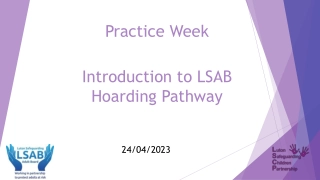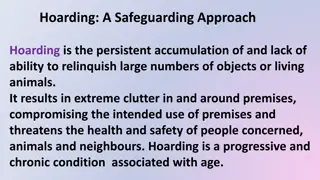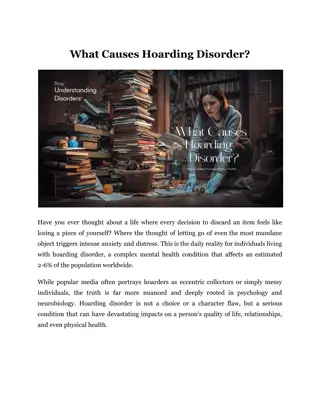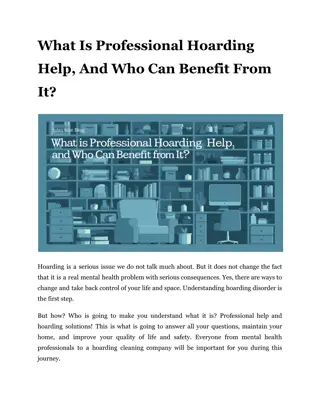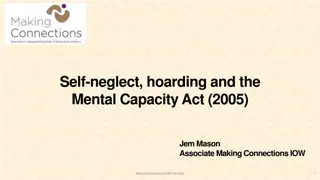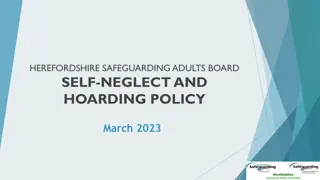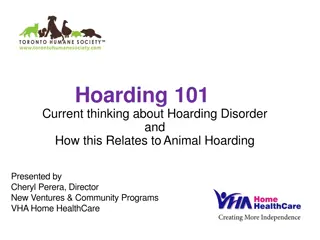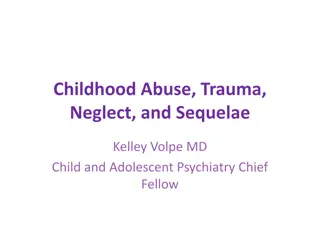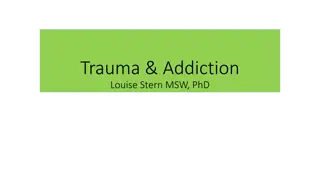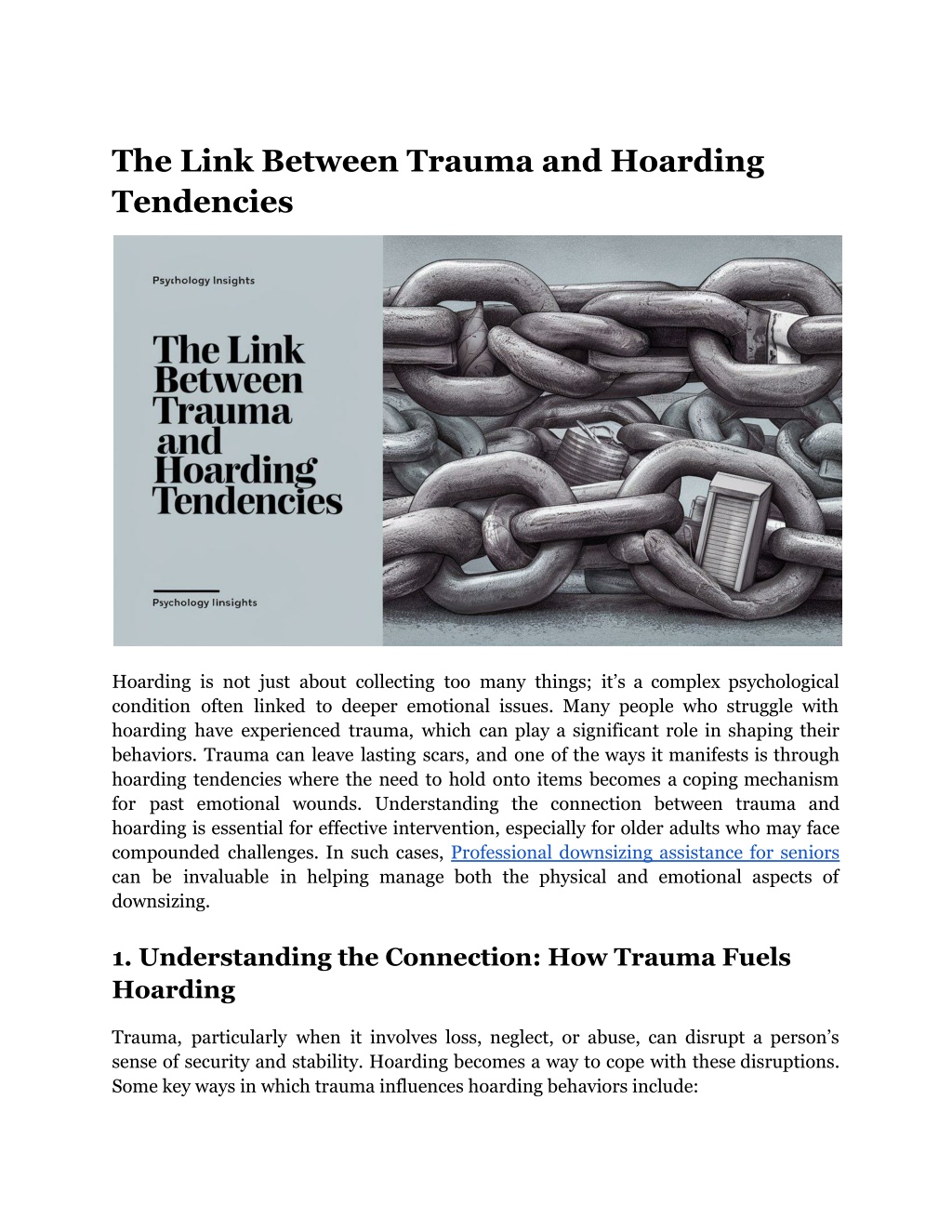
The Link Between Trauma and Hoarding Tendencies
Explore how trauma impacts hoarding tendencies, revealing why past experiences can lead to cluttered lives and emotional challenges.
Download Presentation

Please find below an Image/Link to download the presentation.
The content on the website is provided AS IS for your information and personal use only. It may not be sold, licensed, or shared on other websites without obtaining consent from the author. Download presentation by click this link. If you encounter any issues during the download, it is possible that the publisher has removed the file from their server.
E N D
Presentation Transcript
The Link Between Trauma and Hoarding Tendencies Hoarding is not just about collecting too many things; it s a complex psychological condition often linked to deeper emotional issues. Many people who struggle with hoarding have experienced trauma, which can play a significant role in shaping their behaviors. Trauma can leave lasting scars, and one of the ways it manifests is through hoarding tendencies where the need to hold onto items becomes a coping mechanism for past emotional wounds. Understanding the connection between trauma and hoarding is essential for effective intervention, especially for older adults who may face compounded challenges. In such cases, Professional downsizing assistance for seniors can be invaluable in helping manage both the physical and emotional aspects of downsizing. 1. Understanding the Connection: How Trauma Fuels Hoarding Trauma, particularly when it involves loss, neglect, or abuse, can disrupt a person s sense of security and stability. Hoarding becomes a way to cope with these disruptions. Some key ways in which trauma influences hoarding behaviors include:
Emotional Attachment to Items: When people experience trauma, they may form strong emotional connections to physical objects, seeing them as symbols of comfort or stability. Discarding items can feel like losing a part of themselves or letting go of precious memories. Fear of Scarcity: Those who have faced deprivation or loss may develop a mindset of never enough, leading them to accumulate possessions out of fear that they might need them someday. Difficulty with Decision-Making: Trauma can impair cognitive functions, including decision-making. For some individuals, deciding what to keep and what to discard becomes overwhelming, leading to avoidance and the accumulation of items. 2. How Trauma Manifests in Hoarding Behaviors Not all trauma leads to hoarding, but certain traumatic experiences are more likely to contribute to this behavior. The following are common forms of trauma that often manifest in hoarding tendencies: Bereavement: The loss of a loved one can trigger hoarding as a way to hold onto memories and a sense of connection. Objects associated with the deceased can become symbols of the lost relationship. Childhood Neglect or Abuse: Early experiences of neglect or abuse can result in difficulties with trust, attachment, and decision-making. As a result, hoarding may develop as a protective measure. Major Life Changes: Events like divorce, job loss, or health issues can create feelings of instability, leading individuals to accumulate possessions as a form of self-protection. Recognizing the roots of hoarding is the first step toward recovery. Specialized interventions, including therapy and downsizing services, can help individuals navigate
the complexities of trauma and begin to let go of excessive belongings in a supportive way. Table: Common Traumatic Events That Can Lead to Hoarding Tendencies Traumatic Event Potential Impact on Hoarding Behaviors Loss of a Loved One Increased memories attachment to items linked to Childhood Neglect/Abuse Development of trust and attachment issues Natural Disasters or Accidents Fear of scarcity and accumulating items for future security Major divorce) Life Transitions (e.g., Accumulation of possessions as a means of self-protection Chronic Illness or Disability Increased attachment to items for comfort 3. The Emotional Cycle of Hoarding and Trauma Hoarding often follows a cyclical pattern driven by emotional responses to trauma: 1. Accumulation: The individual collects items in response to distressing emotions. The items provide a temporary sense of comfort or control. 2. Clutter Accumulation: Over time, the items accumulate, leading to clutter that disrupts daily life. This clutter can further increase stress and anxiety. 3. Avoidance: The individual avoids dealing with the clutter, often because discarding items feels like an emotional loss. 4. Reinforcement of Hoarding Behavior: The more clutter builds up, the more challenging it becomes to confront the situation, reinforcing the cycle. Breaking this cycle requires addressing both the behavior and its underlying emotional triggers. This approach involves not just clearing the space but also healing the mind, which can be especially crucial for older adults dealing with lifelong habits. In such cases, senior downsizing firms can offer compassionate decluttering and helping to ease the transition. structured assistance, focusing on 4. Senior Downsizing: Why Trauma Makes It Harder For seniors, the process of downsizing can be even more difficult when hoarding behaviors are involved, especially if trauma is part of the picture:
Longer Emotional History with Possessions: Older adults may have decades of accumulated items that are tied to significant life events. This can make it harder to let go, as each item represents a piece of their life story. Physical Limitations: As people age, physical challenges can make it harder to manage clutter or move items, exacerbating the accumulation. Fear of Losing Independence: Downsizing is often associated with moving to a smaller home or assisted living. This shift can be perceived as a loss of independence, making it emotionally challenging. For seniors facing these issues, downsizing services can provide the necessary support to manage the process sensitively, ensuring that both practical needs and emotional well-being are addressed. Table: Challenges Faced by Seniors During Downsizing Challenge How It Affects Hoarding Long-Term Attachment Emotional Increases difficulty in discarding items Physical Limitations Makes it harder to manage clutter or sort through belongings Fear Independence of Losing Control or Resisting downsizing as a means of maintaining control Health Issues This can lead to further accumulation due to limited mobility Isolation Lack of social support can make it harder to seek help
5. Breaking the Cycle: How to Approach Hoarding Recovery Addressing hoarding involves more than just clearing out items as it s about changing the patterns that drive the behavior. Here are some strategies for tackling hoarding while considering its roots in trauma: Therapeutic Support: Therapy, understand the connection between their trauma and hoarding behaviors. It can also teach strategies for gradually discarding items. particularly cognitive-behavioral therapy (CBT), can help individuals Support Groups: Sharing experiences with others who face similar struggles can reduce feelings of isolation and shame. Gradual Decluttering: Instead of forcing rapid cleanouts, a step-by-step approach can help ease the emotional stress associated with letting go. Utilizing Services: These services provide more than just physical assistance with moving items. They can also offer emotional support, guiding seniors through the downsizing process at a pace that feels comfortable for them. 6. The Role of Downsizing Services in Hoarding Recovery For older adults, hoarding recovery can be particularly challenging. Senior Downsizing Services play an essential role by combining practical help with emotional sensitivity. These services offer: 1. Professional Guidance: Downsizing experts can help sort items and identify what to keep, donate, or discard while respecting the emotional value of belongings.
2. Compassionate Approach: Experienced downsizing professionals understand that items may hold sentimental value, and they work with seniors to ease the decision-making process. 3. Assistance with Transitions: Whether moving to a smaller home, assisted living, or simply decluttering to improve safety, downsizing services help make transitions smoother and less stressful. Wrap Up The link between trauma and hoarding is complex but significant, with emotional scars often manifesting in the need to hold onto items. It's possible to break free from clutter, regain control of your space, and find a sense of calm and comfort again with the right support. Site Article: The Link Between Trauma and Hoarding Tendencies


